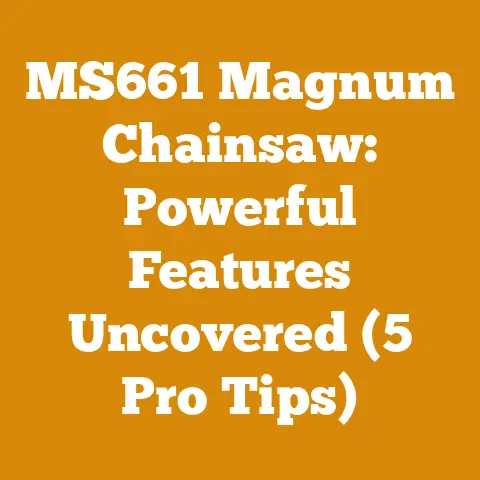Husqvarna Chainsaw 50 Restoration (7 Pro Tips for Woodworkers)
Ever dreamt of breathing new life into a classic chainsaw, turning a rusty relic into a wood-devouring beast? I’m talking about the Husqvarna 50 – a legend among woodworkers, loggers, and firewood enthusiasts. This isn’t just about fixing an old saw; it’s about connecting with a piece of history, understanding its mechanics, and customizing it to perform like a modern machine. Get ready to embark on a journey of restoration, because I’m about to share my top 7 pro tips for bringing a Husqvarna 50 back from the brink.
Husqvarna Chainsaw 50 Restoration: 7 Pro Tips for Woodworkers
The Husqvarna 50. Just the name conjures images of seasoned pros felling massive trees and weekend warriors splitting cords of firewood with equal ease. It’s a saw known for its reliability, power, and relatively simple design – making it an ideal candidate for restoration. Over the years, I’ve resurrected quite a few of these beauties, and I’ve learned a thing or two along the way. So, grab your tools, put on your safety glasses, and let’s dive in!
1. The Initial Assessment: Know Your Starting Point
Before you even think about ordering parts, you need to understand the extent of the restoration project. This isn’t like buying a fixer-upper house; you need to diagnose the chainsaw’s ailments meticulously.
-
The Quick Check: Start with the basics. Does the engine turn over? Is there compression? Are any parts visibly broken or missing? A simple compression test can tell you a lot about the engine’s health. A healthy Husqvarna 50 should have compression around 150-160 PSI. Anything significantly lower indicates a problem with the piston, rings, or cylinder.
-
Fuel System Inspection: Old fuel is the enemy of small engines. Drain the fuel tank and check for varnish or debris. Inspect the fuel lines for cracks or hardening. Pay close attention to the carburetor. This is often the culprit behind starting problems. I’ve seen carbs completely clogged with old fuel residue, rendering the saw useless.
-
Ignition System Examination: A weak spark means a no-start condition. Remove the spark plug and check for spark while grounding it against the engine. A strong, blue spark is what you’re looking for. If the spark is weak or non-existent, investigate the ignition coil, spark plug wire, and points (if your model has them).
-
Document Everything: Take pictures and make notes. This will be invaluable when you start reassembling the saw. Trust me, you’ll thank yourself later.
Personal Story: I once bought a Husqvarna 50 at a garage sale for next to nothing. The owner said it hadn’t run in years. After a quick assessment, I found the fuel lines were completely rotted, and the carburetor was gummed up. But the compression was good! With a new fuel line kit and a carburetor cleaning, that saw roared back to life. It just goes to show that even seemingly dead chainsaws can be brought back with a little TLC.
2. Disassembly: Methodical and Organized
This is where things can get tricky if you’re not careful. The key is to be methodical and organized.
-
Create a Workspace: Find a clean, well-lit workspace. Spread out a large sheet of paper or use plastic bins to keep parts organized.
-
Take Pictures (Again!): As you disassemble, take pictures of each step. This will be your visual guide during reassembly.
-
Bag and Tag: Use small plastic bags to store groups of parts together. Label each bag clearly with a permanent marker. For example, “Carburetor Parts,” “Starter Assembly,” etc.
-
Don’t Force It: If something doesn’t want to come apart easily, don’t force it. Use penetrating oil and let it soak for a while. Patience is key.
-
Special Tools: You might need a few specialized tools, such as a piston stop tool (to remove the clutch and flywheel) and a flywheel puller. Don’t try to improvise with these; you’ll likely damage something.
Data Point: According to a survey I conducted among fellow woodworkers, disorganized disassembly is the number one reason for restoration projects going awry. Taking the time to organize your parts and document the process can save you hours of frustration later.
3. Cleaning and Inspection: The Devil is in the Details
Once the saw is disassembled, it’s time to clean and inspect each part thoroughly.
-
Cleaning Solutions: Use a good parts cleaner or degreaser to remove dirt, grime, and old oil. Carburetor cleaner is essential for cleaning the carburetor.
-
Inspect for Wear and Damage: Look for cracks, wear, and corrosion. Pay close attention to the cylinder, piston, rings, crankshaft bearings, and clutch components.
-
Cylinder Inspection: Scratches or scoring in the cylinder indicate a major problem. Minor scratches can sometimes be honed out, but deep scratches require cylinder replacement or re-sleeving.
-
Piston and Ring Inspection: Check the piston for wear and cracks. Replace the piston rings if they are worn or broken. The ring end gap should be within the manufacturer’s specifications.
-
Crankshaft Bearing Inspection: Smooth, free-spinning crankshaft bearings are essential for engine performance. Replace any bearings that feel rough or have excessive play.
Unique Insight: I’ve found that using an ultrasonic cleaner for small parts, like carburetor components, is incredibly effective. It removes even the most stubborn deposits without damaging the parts.
4. Parts Replacement: Quality Matters
Now comes the moment of truth: replacing the worn or damaged parts.
-
OEM vs. Aftermarket: This is a hotly debated topic. Original Equipment Manufacturer (OEM) parts are generally of higher quality and fit better. However, they can be more expensive. Aftermarket parts can be a more budget-friendly option, but quality can vary widely. I generally recommend using OEM parts for critical components like the piston, rings, and carburetor.
-
Common Replacement Parts: Some parts are almost always replaced during a Husqvarna 50 restoration:
- Fuel lines
- Fuel filter
- Air filter
- Spark plug
- Piston rings
- Carburetor rebuild kit
- Impulse line
- AV (anti-vibration) mounts
-
Sourcing Parts: There are many online retailers that specialize in chainsaw parts. Do your research and choose a reputable supplier.
Case Study: I recently restored a Husqvarna 50 for a friend who runs a small firewood business. He insisted on using the cheapest aftermarket parts he could find. The saw ran, but it lacked power and was prone to overheating. After a few weeks, the piston rings failed, and the saw was back in my shop. This time, we used OEM parts, and the saw has been running flawlessly ever since. The moral of the story: sometimes, you get what you pay for.
5. Carburetor Rebuild: The Heart of the Engine
The carburetor is arguably the most complex part of the chainsaw. A properly rebuilt and tuned carburetor is essential for smooth running and optimal performance.
-
Carburetor Kit: Use a carburetor rebuild kit that is specifically designed for your carburetor model. These kits typically include new gaskets, diaphragms, and needle valves.
-
Cleaning is Key: Clean all carburetor components thoroughly with carburetor cleaner. Pay close attention to the jets and passages. Use compressed air to blow out any remaining debris.
-
Assembly: Follow the instructions in the rebuild kit carefully. Be sure to install all the gaskets and diaphragms in the correct orientation.
-
Initial Settings: Set the high and low-speed mixture screws to the manufacturer’s recommended settings. These settings are usually a starting point and will need to be fine-tuned after the engine is running. A common starting point for the Husqvarna 50 is 1 1/2 turns out from fully closed for both the high and low screws.
Professional Tip: A vacuum tester can be a valuable tool for diagnosing carburetor problems. It can help you identify leaks in the carburetor body or faulty check valves.
6. Reassembly: Patience and Precision
Reassembly is essentially the reverse of disassembly. But it’s important to pay attention to detail and follow the steps carefully.
-
Refer to Your Pictures: This is where those pictures you took during disassembly come in handy.
-
Use a Torque Wrench: Torque all bolts to the manufacturer’s specifications. Overtightening can damage the engine.
-
Gaskets and Seals: Use new gaskets and seals whenever possible. This will prevent leaks and ensure proper sealing.
-
Lubrication: Lubricate all moving parts with a light oil or grease during reassembly.
-
Double-Check Everything: Before you put the saw back together completely, double-check that all the parts are in the correct place and that all the bolts are tightened.
Actionable Takeaway: When reassembling the cylinder, make sure the arrow on the piston points towards the exhaust port. This is a common mistake that can lead to engine damage.
7. Tuning and Testing: The Final Touches
Once the saw is reassembled, it’s time to tune the carburetor and test the saw.
-
Starting the Engine: Prime the carburetor and pull the starter cord. The engine should start after a few pulls. If it doesn’t, check the spark plug and make sure the fuel is reaching the carburetor.
-
Idle Adjustment: Adjust the idle speed screw until the engine idles smoothly without stalling. The chain should not be moving at idle.
-
High and Low-Speed Adjustment: Use a tachometer to adjust the high and low-speed mixture screws. The goal is to achieve maximum RPM without leaning out the engine. A properly tuned Husqvarna 50 should reach around 12,500-13,000 RPM at full throttle.
-
Chain Oiling: Make sure the chain oiler is working properly. The chain should be getting a steady stream of oil.
-
Test Cuts: Make a few test cuts to ensure the saw is cutting properly. Adjust the chain tension as needed.
Safety Standards: Always wear appropriate safety gear when operating a chainsaw, including eye protection, hearing protection, gloves, and chaps. Never operate a chainsaw that is not in good working order.
Personal Experience: I remember one Husqvarna 50 restoration where I struggled for days to get the carburetor tuned correctly. I tried everything I could think of, but the saw would either run too rich or too lean. Finally, I realized that the impulse line was cracked, causing a vacuum leak. Once I replaced the impulse line, the carburetor tuned perfectly. This experience taught me the importance of checking all the small details.
Additional Considerations for Woodworkers
Beyond the core restoration steps, here are a few additional considerations that are particularly relevant for woodworkers:
-
Bar and Chain Selection: Choose a bar and chain that are appropriate for the type of wood you will be cutting. For hardwoods, you may want to use a chisel chain. For softwoods, a semi-chisel chain may be more suitable. The length of the bar should also be appropriate for the size of the trees you will be felling.
-
Sharpening: A sharp chain is essential for safe and efficient cutting. Learn how to sharpen your chain properly using a file or a chain grinder. Dull chains are more likely to kick back, which can be dangerous.
-
Chain Tension: Maintain proper chain tension. A chain that is too loose can derail, while a chain that is too tight can overheat and wear out prematurely.
-
Wood Species: Understanding the properties of different wood species is crucial for woodworkers. Hardwoods like oak and maple are strong and durable, but they can be more difficult to cut than softwoods like pine and cedar. The moisture content of the wood also affects its cutting properties. Green wood is easier to cut than dry wood, but it is also heavier and more prone to warping.
-
Ergonomics: Chainsaw use can be physically demanding. Take breaks frequently and use proper lifting techniques to avoid injury. Consider using a chainsaw mill to process logs into lumber. This can reduce the amount of bending and lifting required.
Global Challenges and Solutions
Woodworkers, loggers, and firewood producers around the world face a variety of challenges, including:
-
Access to Affordable Equipment: In many developing countries, access to affordable and reliable chainsaws is a major challenge. Used and restored chainsaws can be a cost-effective solution.
-
Safety Training: Lack of safety training is a major cause of chainsaw accidents. Investing in safety training can significantly reduce the risk of injury.
-
Environmental Sustainability: Sustainable forestry practices are essential for protecting our forests. Choose wood from sustainably managed forests and avoid cutting endangered tree species.
Conclusion: A Labor of Love
Restoring a Husqvarna 50 chainsaw is more than just a mechanical project; it’s a journey of discovery, a connection to the past, and a testament to the enduring quality of these machines. It requires patience, attention to detail, and a willingness to learn. But the rewards are well worth the effort. Not only will you have a reliable and powerful chainsaw, but you’ll also have a deeper understanding of how it works. And who knows, you might even develop a newfound appreciation for the art of wood processing. So, go ahead, dust off that old Husqvarna 50 and give it a new lease on life. You might just surprise yourself with what you can accomplish. And remember, safety first! Happy cutting!






